Chihuahuan Desert Nature Park Virtual Tour
Welcome to the Desert Discovery Trail at the Chihuahuan Desert Nature Park. There is no need for hiking boots, sunscreen, or water on this virtual tour! During this tour, you will learn about the Chihuahuan Desert and its plants, animals, geology, and early human inhabitants. Enjoy! Stop 1 – The Chihuahuan Desert Stop 2 – Desert Plant Adapatations Stop 3 – Erosion and Soil Formation Stop 4 – Desertification Stop 5 – Desert Animal Adaptations Stop 6 – Humans in the Desert Stop 7 – Effects of Slope & Aspect Stop 8 – Geomorphology Stop 9 – Invertebrates Stop 10 – Geology Stop 11 – Lichens Stop 12 – Animal Evidence Stop 13 – The Jornada Basin | 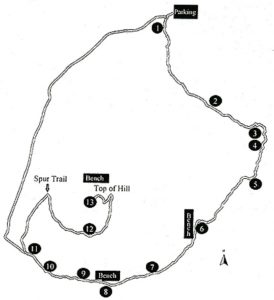 |
The Chihuahuan Desert is the largest of the North American deserts. From where the park is located, it extends almost 200 miles (322 km) north and 600 miles (966 km) south. Most of the 250,000 square mile desert is located in the state of Chihuahua, Mexico. This is where the desert got its name. The climate of the Chihuahuan Desert is relatively mild compared with other deserts, partially due to an elevation that averages 4,500 feet (1,372 m) above sea level. Summers are hot, while winters can be cold. The wet season (July through September) brings more than 50% of the average annual precipitation. In this region of the Chihuahuan Desert, the average annual precipitation is 8.9 inches (22.6 cm). The Chihuahuan Desert is one of the most biologically diverse deserts on the planet. It ranks #1 among deserts for the number of aquatic species and the number of mammal species. More than 300 species of cacti are found here. | 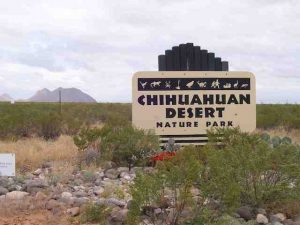 |
We have four dominant Chihuahuan Desert plants in the Nature Park – creosote bush (Larrea tridentata), honey mesquite (Prosopis glandulosa), tarbush (Flourensia cernua), and crucifixion thorn (Koeberlinia spinosa). These plants, along with other plants of the Chihuahuan Desert, have developed numerous adaptations that allow them to cope with the extreme temperatures, low water availability, and high solar radiation found in this environment. Roots and leaves of the plants are often specialized for desert conditions. For example, perennial grass roots that are shallow and dense collect water quickly when it rains. Other plants, like honey mesquite, have deep root systems that can tap into longer-term water sources. Since leaves are a primary source of water loss, it is not uncommon to find desert plants with small leaves (e.g., creosote bush) or with leaves so small they look like they have no leaves at all (e.g., crucifixion thorn). The fishhook barrel cactus (Ferocactus wislizeni) has accordion pleating that allows it to expand and store large quantities of water when it is available. Finally, cacti and some succulents use a special type of photosynthesis that functions only at night when temperatures are lower and humidity is higher, so plants lose less water to evaporation. |  |
The Nature Park has at least eight different types of soil. These differences exist because of the variety of ways that the five soil forming factors (climate, organisms, topography, parent material, and time) interact. These factors, acting together, form soil by altering the physical and chemical nature of the original geologic deposits and rock. At this stop, the steep slope (topography factor), the small amount of vegetative cover (organism factor), and the heavy rainfall intensity (climate factor) cause most of the water to run off. Only a small amount of water goes into the soil. The sand, silt, and rocks (parent material factor) are less likely to break down through chemical weathering processes than in a soil that stays moist for long periods (time factor). As a result, this soil contains more rocks than it would if it were wetter. | 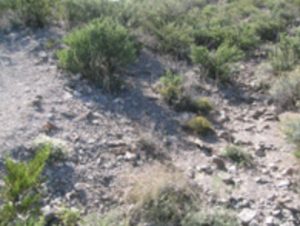 |
Prior to the introduction of domestic livestock, many piedmont slopes within the Nature Park would have supported several species of grasses with scattered shrubs. Grazing and drought have reduced the amount of grass and its capacity to hold soil in place. Runoff water strips away small soil particles (sand, silt, clay) from the unprotected soil and leaves behind the larger gravel that already existed in the soil. Over time, this produces an erosion pavement of gravel that functions like armor to protect the soil from further erosion. The fertile topsoil that once supported grasses is now gone and nutrient-poor subsoil layers are at or near the surface. The white coating seen on some rocks in the area is calcite, a mineral composed of calcium carbonate (CaCO3); some people call this caliche. It is a chemical substance similar to the hard water deposits that are left around faucets in your house. Calcite plugs the pores between sand and gravel, making it “nature’s concrete”. Calcite forms beneath the soil surface, giving soils of arid regions a whitish or gray color. It has been accumulating in this soil for more than 250,000 years. The presence of the white coating at or near the soil surface is evidence of soil erosion. | 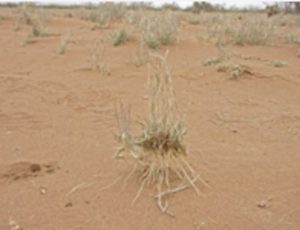 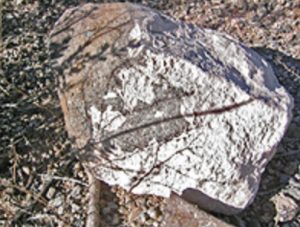 |
Desert animals have a variety of physical adaptations to prevent overheating and reduce water loss. For example, jackrabbits have long ears and insects have impermeable body coverings. Many behavioral adaptations (such as being nocturnal and living in burrows) also enable animals to survive in the desert. The Merriam’s kangaroo rat (Dipodomys merriami) is one of the three kangaroo rat species found in this area. Other species are the banner-tailed kangaroo rat (Dipodomys spectabilis) and the Ord’s kangaroo rat (Dipodomys ordii). Kangaroo rats have specialized nasal passages and kidneys that reduce water loss from their bodies. Spadefoot toads escape the harshest desert conditions by living underground in a state of dormancy during most of the year (estivating). When heavy rains arrive, they come to the surface to feed and reproduce quickly before the water disappears again. Many rodents live in burrows to escape the heat of the day. Other animals, such as snakes and lizards, will occupy abandoned burrows in order to take advantage of the cooler temperatures inside. | 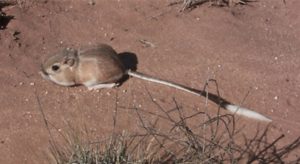 |
Stone tools called manos and metates were used to grind corn and mesquite beans into flour. People and their associated changes to the environment have been here for at least the past 12,000 years. Initially, the climate was cooler and wetter. As conditions became warmer and drier, short-term fluctuations in the climate had major effects on all life – plants, animals, and people. The earliest cultures in this area were present from about 10500 – 6000 B.C. during the Paleoindian period. People were hunter-gatherers, living solely from wild game and plants. They traveled extensively to pursue herds of animals such as mammoths, bison, mastodons, and giant ground sloths. During the Archaic period, from 6000 B.C. to 250 A.D., the large animal species, except the modern bison, were gone. The climate became warmer and drier, and some of the first desert plants appeared. Grinding stones (manos and metates) became more prominent, indicating an increase in the processing of wild plant seeds and nuts. Domesticated plants (corn, beans, and squash) came into use by 3,000 years ago. By no later than 1,700 years ago, fired clay pots, a technology from Mexico, began to be used, marking the beginning of the Formative period (A.D. 250 – 1450). The advent of pottery coincided with an increased reliance on agriculture, increased sedentism, and growing population sizes. By about 1450 – 1500 A.D., pueblos throughout many areas of the southwest were abandoned, pottery traditions ceased and the number of people dropped significantly. Political strife and environmental degradation are two possible reasons for this abrupt abandonment. What became of the people in southern New Mexico is unclear. | 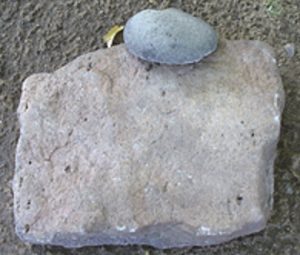  |
Water availability and temperatures of desert mountain slopes vary with slope angle and aspect (the direction the slope faces). On the south facing slope of the hill at the Chihuahuan Desert Nature Park, we can see the high abundance of large prickly pear cactus, ocotillo, and banana yucca. These drought-tolerant species require well drained soils so their roots will not have rot damage from too much soil moisture. On the north facing slope, creosote bush predominates and there are few cacti and other succulents. | 
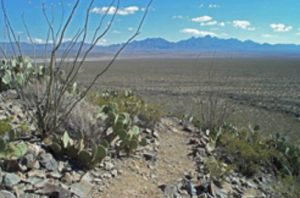 |
| The land’s surface is sculpted through time by wind, water, and earthquakes. Landscapes with similar shapes, the same origin and the same age are called geomorphic surfaces. For example, the fan-piedmont (in the photo to the right) is a gently sloping landform that extends from the base of the Doña Ana Mountains to the basin floor. The mountains are the source of the gravel, sand, silt, and clay that were carried by water to form the fan-piedmont. | 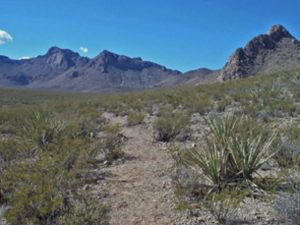 |
There is a mind-boggling array of invertebrates (animals without backbones) essential to providing critically important services, including cycling energy and nutrients through the system. They carry out these vital functions by eating and being eaten, pollinating most of the desert’s plant life, distributing seeds, creating holes that aerate the soil and increase water infiltration, and recycling dead plants, animals, and animal wastes. Large harvester ants (Pogonomyrmex rugosus) and honey pot ants (Myrmecocystus spp.) are just two of the species in a diverse set of invertebrates that live here. | 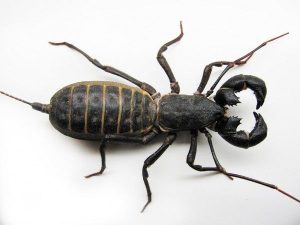 |
Large boulders sometimes appear to be peeling away layer by layer. This is called exfoliation and is an example of a physical rock-weathering process. Water moves into cracks in the rocks, freezes and expands, causing the rock to flake apart. Expansion and contraction from hot desert days and cold nights can also cause the rock to split. As the edges of the coarse-grained monzonite rock break away, it develops into rounded boulders. The process of exfoliation is the first step in soil formation from these large boulders. Physical, chemical, and biological processes will continue to break down the flakes of exfoliated rock into soil-sized particles. The formation of the different rock types and the mountainous topography within the Chihuahuan Desert Nature Park resulted from two different volcanoes.
This hill (above) is the eroded remnant of a volcano that formed about 45 million years ago. The lava flows and mudflows that resulted from this volcano are collectively called the Palm Park Formation. The dark gray angular rocks in the hill are andesite.
This volcano (above) was active approximately 35 million years ago. After erupting, the remaining dense magma intruded into cracks in the earlier Palm Park lava. Over time, the surrounding softer rock weathered, eroded, and washed away, leaving a volcanic dike, a linear projection of hard rock seen in the photo above. This dike is Doña Ana monzonite, a type of granite. | 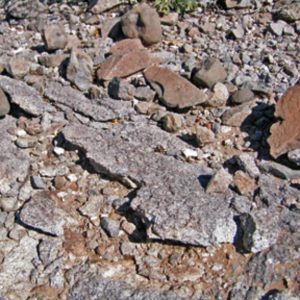 |
|
There are bright yellow, red-yellow, and green patches on the rocks along this part of the trail. These brightly colored lichens are actually two organisms – fungus and algae – in one. The association between the organisms within lichens is so complete that scientists give genus and species names to the lichens; the different colors of lichens you see are different species. Within a lichen, the fungus provides a structural web that protects the alga and provides a suitable environment. In turn, the alga photosynthesizes and provides the fungus with food. When moist, lichens release small amounts of acid that dissolve the rock. This is called chemical rock-weathering and is extremely slow. Sometimes you can find “moss rocks” for sale or find them out in the wild. This is not moss but lichen. Remember, lichen is a living organism and can die if removed from its natural location. |
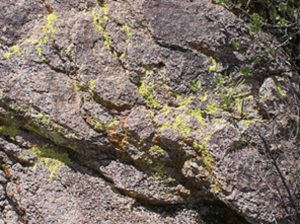 |
Spotting animals in the desert is dependent on the weather and time of day. In the summer, the middle of the day is not the optimal time for animals to be out. While air temperatures may be pushing 100°F, the ground temperature could be over 140°F! But even if you don’t actually get to view any animals, you can tell what lives there by finding evidence of animals such as bite marks on plants and burrows. Under prickly pear cactus and mesquite, you can find piles of sticks, cactus pads, and other materials. These piles are called middens and are created by packrats (also known as woodrats). Middens are occupied by successive generations of solitary packrats and are often also home to beetles, crickets, and a variety of small mites and collembolans (springtails). Some packrat middens are more than 50,000 years old and have been important for making paleoecological reconstructions of an area. The leaves, seeds, bones, and other debris collected for the midden are often found well-preserved by crystallized packrat urine. Examining these fossilized middens tells scientists about the plant community and climate of the area thousands of years ago. | 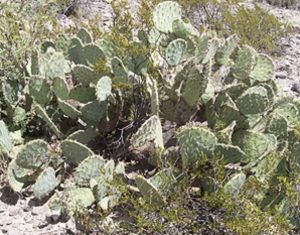 |
The Jornada (pronounced hoor-nah-duh) Basin is a closed system. All the precipitation that falls into the basin stays in the basin. Geologic events spanning 280 million years produced the Jornada Basin. The first event was the deposition of sediments on the floor of a shallow ocean that covered the continent until about 70 million years ago. The resulting sedimentary rocks (sandstone, limestone) were then deformed, tilted, and uplifted to form hills that were the precursors to the Doña Ana and San Andres Mountains. The mountain-building events ended about 33 million years ago. Since that time, erosive forces of water and wind have worn down the lofty mountains, forming the much lower skyline visible today. The rocks eroded from the mountains were deposited in the valley, essentially burying the base of the mountains in their own debris. The deposits in the basin are more than 5,000 feet thick. | 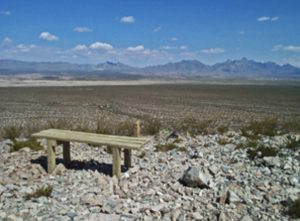 |
| The Desert Discovery Trail you have just enjoyed via this virtual tour is yet another project made possible through the dedication of hundreds of Asombro Institute for Science Education’s volunteers. We are especially grateful to the Asombro Institute’s Site Development Committee chair Justin Van Zee, whose vision, sweat and hard work made the trail into a reality. We also thank scientists Arlene Tugel and Walt Whitford for their assistance in writing the Self-guided Tour Booklet upon which this virtual tour is based. Finally, we thank the dozens of other volunteers who created and help maintain the Chihuahuan Desert Nature Park for all to enjoy. While this virtual tour cannot replace the experience of being immersed in the desert, we hope it gave you some insight about the wonders of this ecosystem. |  |
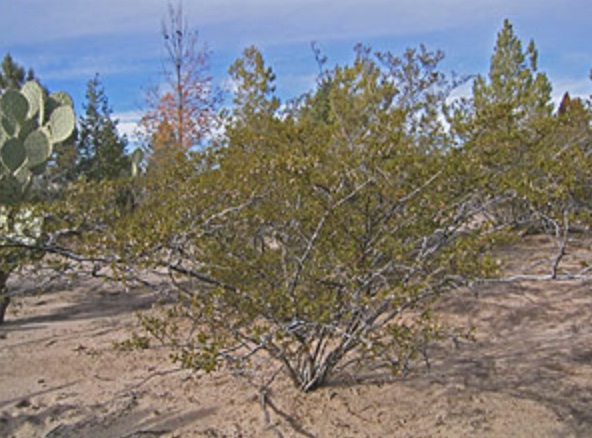
Creosote Bush
Larrea tridentata
Family: Zygophyllaceae
This evergreen shrub is characteristic of the Mojave, Sonoran, and Chihuahuan Deserts.
The creosote bush gives off a sweet fragrance when it rains and deters animals from eating it. The inverted cone shape of the shrub enhances the capture of rainfall as water runs down the stems and enters the soil at the plant’s base. Older shrubs develop a hemispherical shape and capture wind blown leaves and plant fragments that form a litter layer. As the litter decomposes, it produces a “fertile island” of nutrient-rich soil under the plant.
Individual plants can be as old as several thousand years. In fact, clones of creosote bush may be the earth’s oldest living organisms.
Creosote bush produces small yellow flowers and small, hair-covered fruits during the spring and late summer.
Creosote bush has been used in various remedies for arthritis and stomach pain.
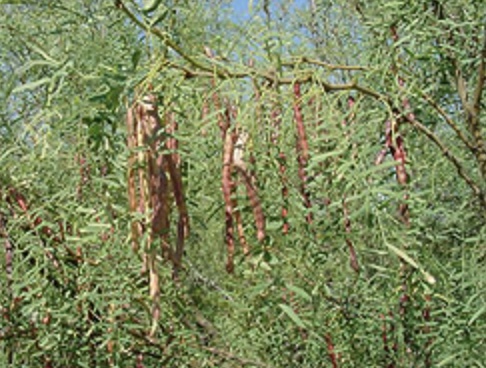
Honey Mesquite
Prosopis glandulosa
Family: Fabaceae (Leguminosae)
The honey mesquite is found from California to Kansas and south to Nuevo Leon, Mexico.
This winter deciduous legume has nitrogen-fixing bacteria associated with its roots. Shed leaves have a high nitrogen content that fertilizes the soil under the plant when the leaves decompose. Mesquite may serve as a “nurse plant,” especially for plants that require nitrogen-rich soils. Plants such as the desert holly (Acourtia nana) are common under the canopies of honey mesquite.
Mesquite taproots are commonly 40 feet (12 m) deep or longer. Long lateral roots are common on plants growing above a cemented calcium carbonate (caliche) soil layer. There are large thorns on the honey mesquite; many animals burrow under the mesquite to benefit from the protection offered by the thorns.
Mesquite produces edible pods that are rich in carbohydrates and protein. The seeds and seed pods are collected by several species of large ants, kangaroo rats, and wood rats. Native Americans and early Spanish settlers ground these pods into a flour that was used for making breads and cakes.
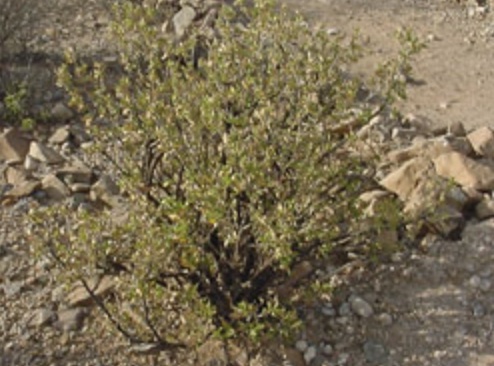
Tarbush
Flourensia cernua
Family: Asteraceae (Compositae)
Tarbush is found only in the Chihuahuan Desert; it is a Chihuahuan Desert endemic.
This deep-rooted shrub gets its name from the resins in the leaves, which have a distinctive, tar-like odor. These resins keep most animals from feeding on the shrub. Scientists have discovered more than 100 chemical compounds in tarbush leaves. Some tarbush plants have more compounds than other, nearby tarbush plants. This may explain why animals chew on some plants and not others.
Tarbush has characteristic black stems that make it recognizable.
Tarbush is a partially winter deciduous shrub (it sheds all leaves in some winters and retains some leaves in other winters). It will remain leafless into the summer months until there is adequate soil moisture. Small, inconspicuous flower are produced on tarbush in late fall.
In northern Mexico, tarbush leaves and flowers have been used to treat indigestion.
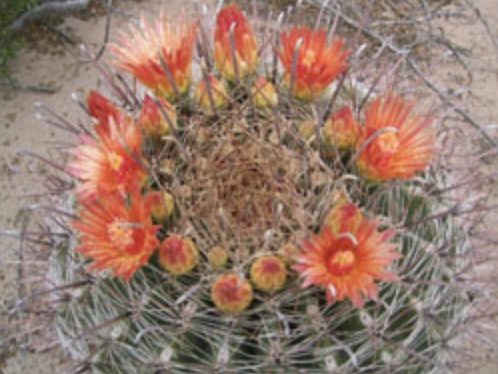
Fishhook Barrel Cactus
Ferocactus wislizeni
Family: Cactaceae
The fishhook barrel cactus is one of the largest barrel cactus species in North America. It is found in desert grassland and desert shrub habitats of the Sonoran and Chihuahuan Deserts.
The accordion-type pleating (or ribs) of the stem allows the barrel cactus to expand and store water after brief periods of heavy downpours. The absorbed water is stored in the form of a slimy alkaline fluid, so contrary to popular myth, it is not readily available for drinking.
This frost-sensitive species is usually solitary but sometimes branches into multiple stems. It generally has a life span of 50 to 130 years.
Yellow to reddish flowers generally peak from July through September, and the yellow fruits can remain on the plant for up to a year. The apex of the barrel cactus sometimes leans to the southwest where heat is the strongest. This allows strong sunlight to hit the top of the plant where dense spination shades the growing stem. Seeds are dispersed by birds and rodents.
Native Americans used barrel cactus pulp to make candy and jelly. The flowers were used to create a yellowish pigment, and the hooked central spines were used as fishhooks.

Jackrabbit
Lepus californicus
Family: Leporidae
Their long ears provide a large surface area for dissipating body heat to the environment. They rest in the shade during the heat of the day. If the shade is even slightly cooler than their body temperature, they can find relief from the heat.
Jackrabbits are not rabbits but hares.
Jackrabbits feed on plants such as perennial flowers and grasses.
Hares differ from cottontail rabbits in birthing their young. While cottontails dig burrows and give birth underground to helpless, blind babies, hares scratch out a shallow depression and give birth above ground. Their babies are born with their eyes open and are ready to leave the nest in a matter of hours.
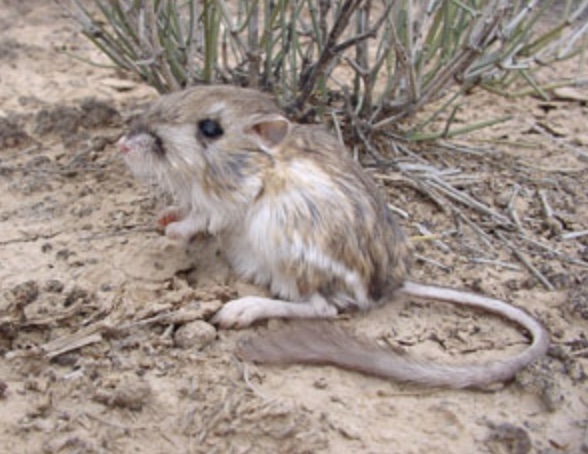
Merriam's Kangaroo Rat
Dipodomys merriami
Family: Hetermyidae
Kangaroo rats are true desert specialists; due to many water-saving strategies and physical structures, a kangaroo rat could live its entire life without ever drinking a drop of water! Kangaroo rats spend the daylight hours in burrows where relative humidity is very high and temperatures are moderate (around 80°F). They emerge to feed on seeds at dusk and at dawn. A modified kidney allows the kangaroo rat to concentrate its urine, thus reducing water loss. Special nasal passages further minimize water loss as a kangaroo rat breathes.
Kangaroo rats get their name from their jumping ability, which resembles that of kangaroos.

Spadefoot Toad
Spea multiplicata
Family: Pelobatidae
While it may seem strange to have amphibians in an arid habitat, there are several amphibians found in this region of the Chihuahuan Desert. One such animal is the spadefoot toad. These animals spend most of their lives underground estivating (living underground in a state of dormancy). When heavy rains arrive, they dig to the surface to feed and reproduce quickly before surface water evaporates.
A sharp-edged black tubercle (“spade”) on a toe of each hind foot helps them dig in the soil.
A unique characteristic of a true spadefoot toad is the vertical pupil of the eye.

Harvester Ants
Pogonomyrmex spp.
Family: Formicidae
These harvester ants live in colonies with up to a thousand workers. They collect seeds that are subsequently stored in the nest to feed the larvae. They also collect termites and other insects whenever these are available.
Harvester ants have a potent sting. In fact, for mammals, the harvester ant’s venom is ten times more toxic than a rattlesnake’s venom. Fortunately, the dose carried by a single ant is small, so one sting is painful but not medically significant. Multiple stings, or the rare case of an allergic reaction to the venom, should be taken seriously.
Harvester ant nests can be several feet down and are clear of vegetation at their entrance.
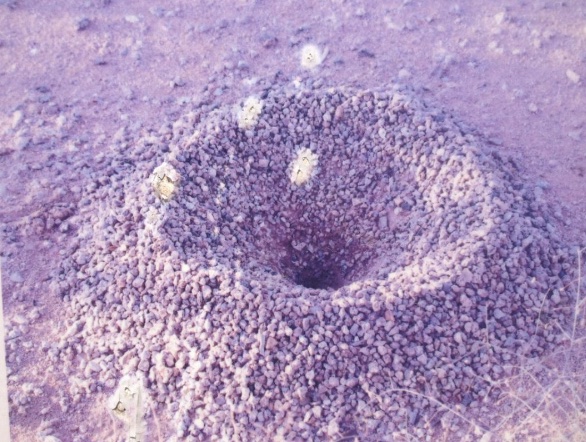
Honey Pot Ants
Myrmecocystus spp.
Honey pot ants are known for their ability to store large amounts of nutritious liquid in their body. These ants will feed off the sugary nectar of desert flowers after a rain. Specific ants, known as repletes, will be engorged with this nutritious liquid by other worker ants. Repletes store food for the colony, as they hang from the ceiling of their underground nests. They remain engorged until the dry season when their reserve food supply is needed.
Due to the nutritional value of honey pot ants, many other animals look to prey on honey pot ants for additional food and liquids. This includes other invertebrates, animals and even humans!

Bite Marks On Plants
Prickly pear cactus can be found with large bite marks. Prickly pear is an important resource for many animals because of its high water and nutrient content. During winter, black-tailed jackrabbits and desert cottontail rabbits eat the pads, somehow avoiding the spines or biting the spines from the pads. Packrats feed on prickly pear by peeling the surface layer off the prickly pear pads.
During the winter months, rodents and rabbits frequently dig near the base of prickly pear in order to eat the roots. In most cases, the animals do not eat all of the pads, and the cactus produces new pads in the spring and early summer. Pads that fall off can sprout roots from any place the areoles (where spines are attached) touch the soil.


